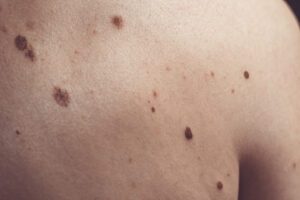
If you’re looking for dermatologists in the area around Stockbridge, GA, mole removal might be on your mind. Moles are common skin lesions that can appear anywhere on the body. While most moles are harmless, it is important to have them removed if they become cancerous. mole removal is a simple procedure that can be done in a dermatologist’s office. In this blog post, we will discuss everything you need to know about mole removal, including whether or not it is covered by insurance. We will also explore the different mole removal methods and discuss why mole removal is an important procedure.
What Are Moles?
Moles are a common type of skin growth that can be cancerous, non-cancerous, or borderline in nature. Some opt to remove non-cancerous moles for aesthetic reasons, but typically mole removal is spurred on by the presence of cancerous moles or those that could develop into cancer.
Moles are also sometimes referred to as a beauty mark or a nevus. Moles can develop over time or be present at birth, and can sometimes last up to 50 years. A mole stands out from other parts of your skin with different coloration than your natural skin tone—typically a darker shade. The average person can have as many as 40 moles by the time they reach 20 years old, though they can expect those moles to change with time. Sometimes, hairs will grow out of the mole, or it will become raised off the surface of the skin or change color.
What Are the Different Kinds of Dermatological Moles?
Moles are incredibly common and most people have between 10-40 moles at any given time over the course of their adult life—but what are the different kinds of moles? Dermatological moles can be classified in the following three categories: common nevi, cysplastic nevi, and congenital nevi.
With common nevi, the mole may appear pink, brown, or tan, is typically a small growth with a distinctive edge, and is considered a “normal” (in other words, non-cancerous) mole.
Dysplastic nevi are irregular in shape and are generally larger than the end of a pencil eraser. These types of moles tend to have uneven coloration throughout with less solid borders. Dysplastic nevi are hereditary and may increase an individual’s likelihood of developing melanoma (skin cancer). As such, these types of moles should be checked regularly by a dermatologist.

Congenital nevi are the moles you were born with, occurring in about 1% of all people. These moles are also more likely to turn into melanoma than moles that develop after birth—especially if it is greater than 8 millimeters in diameter or larger.
Can Mole Removal Prevent Cancer?
Depending on the nature of your moles, having them removed may help to prevent them from developing into melanoma. This is why regular skin cancer screenings are so vital and should be incorporated into a healthy adults routine healthcare checkups. Skin cancer screenings can be done by a professional dermatologist or even done at home. If you suspect you have a mole that may be malignant, it is crucial to have a qualified dermatologist take a look at it right away.
How Does Mole Removal Work?
Most mole removal is a simple outpatient procedure that a qualified dermatologist can accomplish in minutes. To surgically remove a mole generally involves a local anesthetic to numb the area around the mole and then excising or surgically removing the mole. This procedure may require stitches, depending on the depth of the mole, and can leave a scar. Patients with more melanin in their skin may experience keloid scarring or changes in pigment at the excision site.
Will Mole Removal Leave a Scar?
The answer to this question is, “it depends.” Depending on the size and depth of your mole, and even in some cases the natural pigmentation of your skin, excising a mole may require stitches which will likely scar. However, not all mole removals require stitches, making them less likely to leave a mark.
Why Mole Removal Is Important
Skin cancer screenings should be done at least once annually starting at around 20 years of age to ensure a person’s skin—their largest organ—is healthy and cancer-free. Skin cancer is the most common type of cancer in the U.S, with a projected one in five Americans will get skin cancer over the course of their life. To put this into perspective, nearly 10,000 Americans are diagnosed with cancerous melanoma every day.
Moles might be a nuisance to you aesthetically, but they can develop into something deadly if left unchecked and untreated. It is especially important to have moles screened that reappear after being removed. This is usually due to some of the mole skin cells being left behind after the procedure, which allow the mole to grow back. This is why it is often strongly recommended to schedule a follow up appointment about six months out after a mole removal.
Which Mole Removal Method Is Best?
While some people claim that it is possible to remove moles yourself at home, it is generally considered best practice to have a professional dermatologist do this for you in a sterile atmosphere. There are four main kinds of mole removal, detailed below:
- Freezing: This method involves the use of liquid nitrogen to freeze off moles that have not reached deeper dermal layers of skin. Freezing off moles is reserved for non-cancerous moles.
- Shaving: To remove a mole using this method, a dermatologist will usually numb the local area and begin removing layers of the mole with a scalpel.
- Excision: Also known as cutting out the mole, this treatment also involves a local anesthetic applied to the area, which is then operated on using surgical scissors or a scalpel. Generally reserved for deeper moles than those that can be removed with shaving, this type of procedure may require stitches to close the remaining wound, which may scar.
- Laser removal: This type of mole removal is also reserved for non-cancerous moles that are not raised above the surface of the skin. This treatment involves jets of light radiation to break down the skin cells of the mole, which usually takes between two and three treatments. Typically, laser removal is recommended for cases where patients need to remove multiple moles at once, or on areas that are challenging to work on such as the ears.
Is Mole Removal Covered By Insurance?
Mole removal can be covered by insurance, so long as the procedure is necessary for your continued health, comfort, and wellbeing and not in pursuit of an aesthetic choice. For example, if a mole is painful, itchy, or obstructs your daily activities such as blinking or combing your hair, you may be able to get your mole removal covered by insurance. As always, contact your local agent for details on your coverage plan before making an appointment.
Stockbridge, GA Mole Removal
There are more moles in number than there are people on the planet—some are cancerous and others are not. The important thing to remember is that moles can evolve over time, so keeping an eye on them as they change can keep things from escalating into melanoma, or even just mild discomfort. With the simple, outpatient nature of mole removal, you can be on your feet and back at it just minutes after the procedure.
Are you looking for Stockbridge, GA mole removal? Contact National Healthcare Center today to make an appointment with a professional dermatologist!

